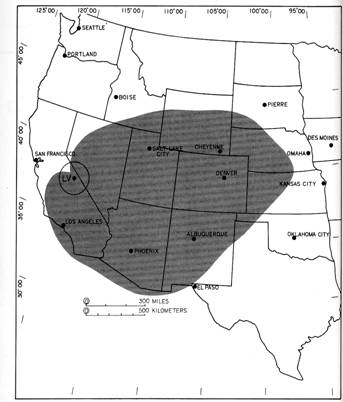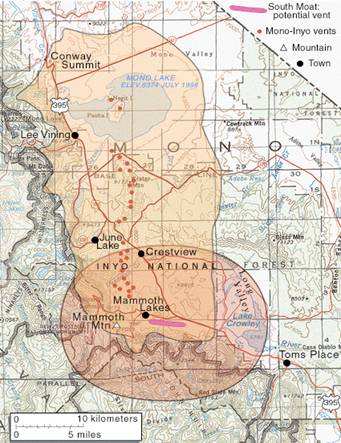Geology and Natural Heritage of the Long Valley Caldera
The Volcanic History of the Long Valley Caldera Region
Jessica Jarosinski
Fig. 1. Map of Long Valley (http://vulcan.wr.usgs.gov/Imgs/Gif/LongValley/Maps/)
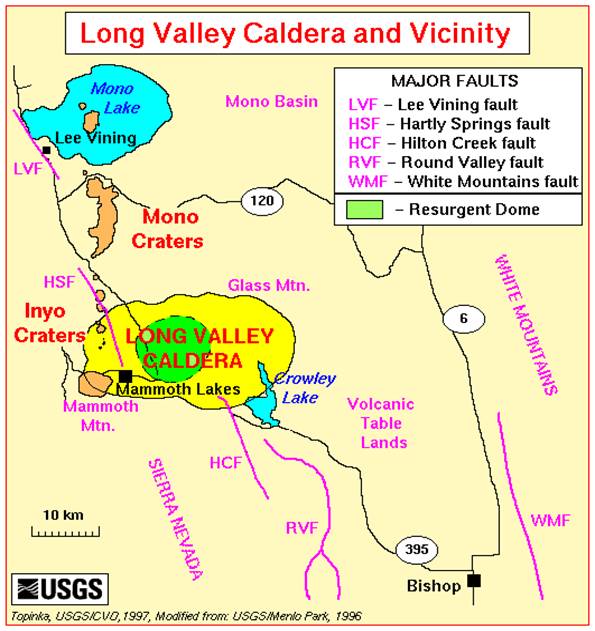
Abstract
This is a general overview of the volcanic history of the Long Valley Caldera region of eastern California. It begins with the pre-caldera volcanic history dating back 4 million years ago when basaltic lava flows dominated the region. Then the magmatic composition changes and the area are dominated by rhyolitic lava flows. The gigantic Bishop Tuff eruption is a fine example of these rhyolitic lava flows and an eruption that changed the entire landscape of the area. Particular attention is given to the Bishop Tuff eruption because of the great impact it had on the geology and volcanism of the surrounding area. Volcanism did not end after the huge Bishop Tuff eruption, but continued on with a vengeance for years after the caldera formation. The formation of the Mono-Inyo craters is discussed as well as the current dangers of what is believed to still be a volcanically active zone.
Introduction
The Long Valley region of eastern California is a breeding ground for volcanic activity. It has a long intricate history of volcanism that continues into the present day. The peak of that history was the formation of the Long Valley caldera by an explosive, super volcano. There are many different types of volcanoes ranging from effusive to explosive (Class notes, spring 2010). There are various factors that influence how a volcano will erupt including: magma composition, gas content, and pressurization (Class notes, spring 2010). Explosive volcanoes have magma rich in silica and high in gas content (Harris, 1988). This silica makes the magma extremely thick and viscous (Class notes, spring 2010). The combination of the viscous magma and the weight of the overlying rock above the magma body make it difficult for the gas to expand and create great pressure within the magma chamber (Class notes, spring 2010). Once the strength of the pressure in the magma chamber exceeds the strength of the overlying rock, the gas comes out of solution violently and with an explosive release of pressure (Harris, 1988). This great release of pressure sends pyroclastic material flying into the air, often in a plinian-type eruption and can create a caldera (Class notes, spring 2010). The word caldera comes from the Portuguese word “Calderia” meaning cauldron (Bardintzeff & McBirney, 2000). This is fitting because of the low relief, circular shape of calderas.
Felsic calderas are formed by these massive eruptions of silica-rich pyroclastic flow (Bardintzeff & McBirney, 2000). The initial eruption opens a vent and ejects material into the sky in a great plinian column (Bardintzeff & McBirney, 2000). The pyroclastic materials flow down the edges of the volcano and as the magma levels underground lower, the entire structure caves in due to a lack of support (Bardintzeff & McBirney, 2000). This collapse causes the formation of the caldera (Bardintzeff & McBirney, 2000). Later, smaller eruptions will often form uplift domes and cones on the caldera floor (Bardintzeff & McBirney, 2000). The Long Valley Caldera is a felsic caldera. It was formed approximately 760,000 years ago by the Bishop Tuff eruption (Bailey, 1976). It is a 17 X 32 km oval shaped depression located on the eastern front of the Sierra Nevada mountain range in California (Bailey, 1976). On a map it is 50 km west of the town of Bishop and 30 km south of Mono Lake [refer to fig.1] (Bailey, 1976). It has a complete area of 450 km2, while its magma chamber is believed to be approximately 10 km in diameter with a depth of 8-10 km (Bardintzeff & McBirney, 2000). While it is generally assumed that calderas have large intrusions that lie beneath them, it is rarely possible to determine their exact structure (Bardintzeff & McBirney, 2000). In the case of the Long Valley Caldera’s magma body, scientists used seismic studies to determine its dimensions (Bardintzeff & McBirney, 2000). However, the dimensions cover only the part that is still fairly molten, the shape and size of the whole body is unknown (Bardintzeff & McBirney, 2000). This region has a long volcanic history that dates back long before the eruption of the Long Valley Caldera, that began 4 million years ago during the Pliocene time and has continued into the Holocene (Bailey, 2004).
Pre-Caldera Volcanism
A period of volcanism in the Long Valley region began 4 million years ago following the uplift of the Sierra Nevada Mountains and the opening of the Gulf of California (Bailey, 2004). While the mountains were uplifted the earth’s crust stretched and faulted near the face of the mountains (Konigsmark, 2002). This allowed for magma located deep within the crust of the earth to flow upward between the broken rocks in the faulted areas (Konigsmark, 2002). This early volcanic activity, between 3.8 and 2.5 million years ago, was dominated by basaltic eruptions (Bailey, 2004). These basaltic eruptions originated from vents that were strewn over 4000 km2 (Bailey & Hill, 1985). The earliest eruptions created massive basaltic lava flows that can still be found in the Adobe Hills located near the edges of Long Valley and in the High Sierras (Harris, 1988).Glass Mountain
Around 3-2.6 million years ago more silicic lavas such as quartz latites and andesites began to erupt (Metz, & Manhood, 1985). These can be found in or near the northern, western, and southern edges of the caldera at locations such as Bald Mountain and the San-Joaquin Mountain (Metz, & Manhood, 1985). The magmatic composition of the area continued to change over time and from 2.5-0.7 million years very few basaltic lavas flowed (Bailey, 2004). The majority of later volcanic rocks of the region were rhyolitic. Rhyolite magma is a viscous, silica-rich magma that does not flow as easily as basaltic magma (Lipshie, 2001). The rhyolitic flows of Glass Mountain and the Bishop Tuff eruption are both associated with the silicic magma chamber that formed under the current Long Valley region (Harris, 1988).The earliest volumes of rhyolitic lava formed Glass Mountain (Harris, 1988). Glass Mountain is a collection of shallow intrusions, domes, and flows located along the northeast edge of the present day caldera (Bailey, 1976). They are flanked by pyroclastic deposits made of ash fall, small ash flows, and pumice (Bailey, 1976). This complex of domes, flows, and pyroclastic matter covers approximately 130 km2 (Metz, & Manhood, 1985). The eruptions at Glass Mountain began with explosive rhyolitic eruptions that threw pumice ash and lapilli high into the air creating a crater (Lipshie, 2001). The ash and lapilli fell and blanketed the immediate landscape around the crater forming a tephra ring (Lipshie, 2001). Once the initial pressure was released magma continued to rise up the vent and eventually formed a thick, almost solid, obsidian plug in the floor of the crater (Lipshie, 2001). The plug continued to grow and build the dome got bigger (Lipshie, 2001). This eventually filled up the crater, spilled over, and swallowed up the tephra ring (Lipshie, 2001). Well exposed vents and intrusive centers can be found in the shape of an arc on the south face of Glass Mountain (Bailey, 1976). The arc is nearly parallel to the northeast wall of the caldera which means that their location could be influenced by a ring-fracture system, which would suggest that they represent early outflow from the Long Valley magma chamber (Bailey, 1976).
Caldera Formation
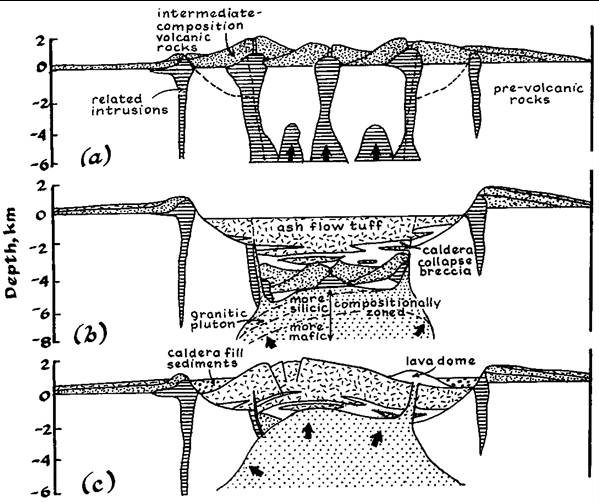
Fig. 2. (a) The caldera before its collapse. It sits over high intrusions while new, lower intrusions (denoted by the thick arrows cause uplift in the crust. This uplift causes fracturing on ring-faults (dotted lines). (b) Right after the caldera collapse ash air falls and flows fill up the bottom and magma continues to make its way back up to the surface. (c) As magma continues to push up towards the surface post-caldera doming and volcanism takes place. (Bardintzeff & McBirney, 2000)
Bishop Tuff Eruption
Fig. 3 Bishop Tuff ash fall layer (Harris, 1988).
The Long Valley magma chamber collapsed 760,000 years ago with the momentous eruption of the Bishop Tuff (Bailey, 1976). This eruption began in a vent just west of the Hilton Creek Fault (Lipshie, 2001). Silica-rich, highly gaseous, rhyolite magma began to rise through a series of fractures in the earth’s crust. The gas was not able to escape the thick magma until the pressure from the overlying rock was removed; however, once it reached the surface the gas was able to expand explosively (Harris, 1988). Scorching ash was sent out of the fractures and high into the air by the expanding gas (Harris, 1988). All together over 150 cubic miles of volcanic ash was hurled out of the volcano, some of which was pitched straight up into the air 8 miles high while lighter fragments were carried by the wind as far east as Nebraska and Kansas , which can be seen in figure 3 (Konigsmark, 2002). This massive amount of material erupted within a very short time period, approximately 6 days (Hildreth, & Wilson, 2007). The air fall ash was the first layer of Bishop Tuff to be laid down (Konigsmark, 2002). After the air fall, a series of ash flows spilled down the flanks of the Long Valley volcano, and all together the air falls and ash flows of this eruption submerged 580 square miles California and Nevada (Harris, 1988). Some of the pyroclastic material flowed so quickly and with such force that it ran over the Eastern face of the Sierra Nevada crest and ran into the San Joaquin River (Harris, 1988). It also flowed south towards Owens Valley, the town of Bishop, and Big Pine (Konigsmark, 2002).
After the Bishop Tuff eruption, the partially emptied Long Valley magma chamber collapsed in, forming what we now know as the Long Valley caldera (Bailey, 1976). The collapse took place along a 12 x 22 km ring-fault zone that was activated once half of the magma was erupted from the magma chamber (Hildreth, & Wilson, 2007). However, the current caldera is larger, measuring 17 x 32 km, because of post-eruption slumping and erosion (Hildreth, & Wilson, 2007). Immediately after the roof of the chamber collapsed, the caldera was close to 3 km in depth, but then was subsequently filled up to 2/3 of the way with erupted ash fall and flows (Konigsmark, 2002). Figure 2 gives a visual of where the ring-fault zones might have been and how the caldera would have collapsed according to their location. It also shows how much of the caldera is often filled up by the previous eruptions material.
Bishop Tuff Structure
The volcanic tableland, which covers a lot of Owens Valley, is one of the most extensive exposures of the Bishop Tuff (Konigsmark, 2002). Compositionally the Bishop Tuff is almost homogenous from top to bottom but is slightly differentiated by how the rhyolitic magma was layered as it erupted (Bailey, 1976). In areas where the ash fall was thicker, chiefly the center, the searing ash fused together to form extremely hard, rough, welded tuff (Konigsmark, 2002). This is what most of the tableland is made of (Konigsmark, 2002). At the bottom of the Bishop Tuff is a layer of unconsolidated, white pumice ash. This was the material that was first to be thrown into the air and first to fall back to the ground below (Konigsmark, 2002). This layer is between 10-15 feet thick (Konigsmark, 2002). The next layer is at least 500 feet thick of ash flows that followed the air falls (Konigsmark, 2002). Where ash flows were thinner near the margins of the flow, ash was not welded and became unconsolidated tuff (Konigsmark, 2002).The current state of the Bishop Tuff can be used to interpret the state of the magma chamber beneath Long Valley before its collapse. According to Wes Hildreth, the magma chamber was originally compositionally zoned, and the current chemical gradient of the Bishop Tuff shows an inverted account of the pre-erupted magma chamber (Bailey & Hill, 1985). When moving up the layers of erupted material, there is a decrease in the amount of silica (Lipshie, 2001). According to Wes Hildreth, this is an indication of the advancing crystallization within the magma chamber (Lipshie, 2001). Simply put, less dense silicic magma lies on top of more mafic magma (Francis & Oppenheimer, 2003). This can be seen in section (b) of figure 2. Roy Bailey suggests that the earlier basalt and andesite flows of the region, which have a silica content on 48-56% compared to the 75% of later rhyolites, were tapped from a source much lower than the current Long Valley chamber (Lipshie, 2001).
Post-Caldera formation VolcanismResurgent Doming & Rhyolite Flows
Volcanism in the Long Valley region did not end with the formation of the caldera. After the Bishop Tuff eruption, between 730,000-63,000 years ago, new magma began to rise and replenish the magma reservoir (Bailey, 1976). The influx of new magma created pressure on the overlying rock and caused resurgent doming near the center of the caldera floor [refer to section (c) of figure 2] (Konigsmark, 2002). The location of the resurgent dome is attributed to the structural weakness of the adjacent roof pendent where many pre-caldera faults are located (Bailey, 1976). During the resurgent doming process, 100-500 meters of tephra and lavas known as “early rhyolites” were expelled (Bailey, 1989). These rhyolites are very silica-rich, up to 75%, and crystal-poor which suggest that they erupted at very hot, almost liquid temperatures (Bailey, 1976). The crystal-poor state of these rhyolites is very different to the crystal-rich Bishop Tuff (Bailey, 1989). The difference between the magmatic conditions of these two rhyolites, which came from the same magma chamber, supports the concept of a zoned magma chamber. Early rhyolites were produced from twelve different eruptive centers and the resurgent dome was completed within 100,000 years of the initial caldera collapse (Bailey, 1976). Currently the resurgent dome is approximately 450 meters above the valley floor and continues to swell with each year (Konigsmark, 2002).
The next stage of volcanism began 500,000 years ago when rhyolitic magmas were emplaced around the fringes of the resurgent dome (Lipshie, 2001). These are known as “moat rhyolites” because they erupted from three vents found in the caldera moat (Bailey, 1976). They erupted in a clockwise ring around the dome at intervals of 200,000 years; 500,000, 300,000, and 100,000 years ago (Bailey, 1976). The moat rhyolites are highly pumiceaous and have a silica content approaching 75 percent (Bailey, 1976). However, their higher crystal content suggests that they erupted at lower temperatures and were therefore more viscous than their preceding “early rhyolites” (Bailey, 1976). After the early rhyolites, between 220,000-50,000 years old, rim rhyodacites began to be produced at ten different vents near the southwest rim of the caldera (Bailey, 1989). A series of rhyodacite flows and domes constructed what is now Mammoth Mountain (Lipshie, 2001).
Mono-Inyo Chain
The most recent volcanic activity can be found at the Mono-Inyo crater and dome chains, the older of which is the Mono Craters. The Mono Craters are a chain of combined domes, craters, and coulees 17 km long (Bailey, 1989). The rhyolitic magma that produced this chain began to flow approximately 4,000 years ago (Lipshie, 2001). From trace-element chemistry experiments it has been determined that the rhyolite of the Mono Craters did not come from the Long Valley magma chamber but from a neighboring magma chamber possibly located under the Mono chain (Lipshie, 2001). The youngest of the Mono Craters is Panum Crater, located at the north end of the chain, which is approximately 700 years old (Lipshie, 2001). At the same time volcanic activity at the south end of the Inyo-chain was ensuing (Lipshie, 2001).Just like the Mono chain, the Inyo chain is also made up of a series of domes and craters but they date back to 6000-550 years ago (Lipshie, 2001). Unlike the Mono chain the Inyo chain is a mix of rhyolite and rhyodacite lava (Bailey, 1976). This mix is believed to come from a dike system that taps into more than one magma chamber (Lipshie, 2001). There is a north trending fissure located along the Inyo chain between Long Valley and the Mono Craters which could be a conduit that pulls from both the magma chamber located under the Long Valley caldera and the Mono area chamber (Bailey, 1976). The Inyo-craters have three craters at the south end that were formed by explosive eruptions (USGS website, “Geological history,”). The ejected material created a crater and flew into the air in a column of ash and pumice (USGS website, “Geological history,”). This explosion was followed by a phreatic, steam-driven explosion (Bailey, 1976). This occurs when shallow magma comes into contact with ground water and flash heats the water into steam, causing an explosion (Bailey, 1976). Once most of the volatile gases in the magma had been released during the early explosions, magma continued to seep out of the ground and created thick domes (USGS website, “Geological history,”). Figure 4 shows the major domes and craters of the Mono-Inyo chain and their approximate ages. Given the young age of the Mono-Inyo chain’s volcanic activity, it is assumed that this area is currently an active volcanic zone meaning that future eruptions are plausible (Bailey, 1976).
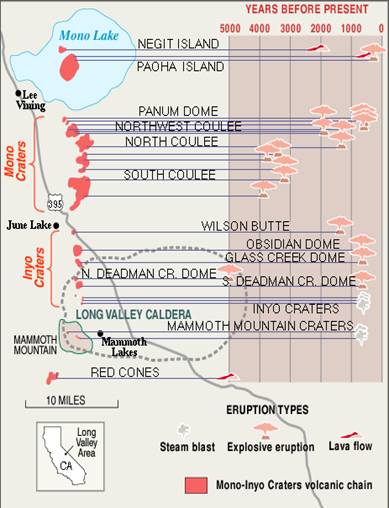
Fig. 5 The major volcanic formations of the Mono-Inyo chain, the majority of which were major explosions. (USGS website, “Future…”)
ConclusionThe chronic volcanism of the Long Valley region of California evokes concern within the scientific community. The volcanism of this region is relatively young when looked at from a geological perspective so the worries about future eruptions are not unfounded. Throughout the 1980’s and 1990’s there has been an increase in volcanic unrest in many different sectors of the region (USGS website, “Volcano hazards in,”). There have been recorded earthquake swarms, ground deformation at the resurgent dome and others, and CO2 gas emissions coming from vents that have had a fatal effect on trees and even some humans (USGS website, “Volcano hazards in,”) . Judging from past eruptions, mostly the most recent ones of the Mono-Inyo crater chain, another sizeable eruption could do serious damage to the surrounding communities. There is a potential for both explosive and non-explosive eruptions (USGS website, “Volcano hazards in,”). Explosive eruptions could produced extremely quick-travelling pyroclastic flows and air fall while non-explosive eruptions could produce thick lava flows and domes (USGS website, “Volcano hazards in,” ) . Figure 5 shows designated hazard zones in case an eruption should occur. The USGS says that with the current eruption frequency noted for the Mono-Inyo craters over the past 5000 years the probability of an eruption is very low; less than 1% in a given year (USGS website, “Volcano hazards in,” ) .
Although this probability seems low, nature is an unpredictable creature. With the past, steady volcanic history of the Long Valley region dating back 4 million years, a large eruption does not seem unlikely. An eruption like that of the Mono-Inyo craters would be devastating, let along an eruption comparable to the Bishop Tuff. Luckily, there are herds of scientists constantly keeping track of the tectonic, and volcanic unrest of the area, and although their efforts can not yield a precise eruption schedule, they may be able to give some fair warning.
References
Bailey, R.A., & Hill, D.P. (1985). Active tectonic and magmatic processes beneath long valley caldera, eastern california: an overview. Journal of Geophysical Research, 90(B13), 111-120.
Bailey, R. (1989). Quaternary volcanism of long valley caldera and mono-inyo craters, eastern california, field trip guidebook t313. N.W., Washington, D.C.: American Geophysical Union.
Bailey, R. United States Geological Survey, (2004). Eruptive history and chemical evolution of the precaldera and post caldera basalt-dacite sequences, long valley, california: implications for magma sources, current seismic unrest, and future volcanism (professional paper 1692). Reston, VA: U.S. Geological Survey.
Bailey, R. (1976). Volcanism, structure, and geochronology of long valley caldera, mono county, california. Journal of Geophysical Research, 81(Bailey, 2004), 725-744.
Bardintzeff, J.M, & McBirney, A.R. (2000). Volcanology. Sudbury, MA: Jones and Bartlett Publishers.
Francis, P., & Oppenheimer, C. (2003). Volcanoes. Oxford, NY: Oxford University Press.
Future eruptions in california’s long valley area—what’s likely?. (2004) Retrieved from http://pubs.usgs.gov/fs/fs073-97/index.html
Geological history of mono-inyo crater volcanic chain. (n.d.). Retrieved from http://volcanoes.usgs.gov/lvo/about/inyo/history.php
Harris, S.L. (1988). Fire mountains of the west: the cascade and mono lake volcanoes. Missoula, MS: Mountain Press Publishing Company.
Hildreth, W., & Wilson, C.J.N. (2007). Compositional zoning of the bishop tuff. Journal of Petrology, 48(5), 951-999.
Konigsmark, T. (2002). Geological trips: sierra nevada. Mendocina, CA: GeoPress.
Lipshie, S.R. (2001). Geological guidebook to the long valley-mono craters region of eastern california. Santa Ana, CA: South Coast Geological Society.
Metz, J.M., & Manhood, G.A. (1985). Precursors to the bishop tuff eruption: glass mountain, long valley, california. Journal of Geophysical Research, 90(B13), 121-126.
Volcano hazards in long valley-mono lake area, california. (n.d.). Retrieved from http://volcanoes.usgs.gov/lvo/hazards/index.php
